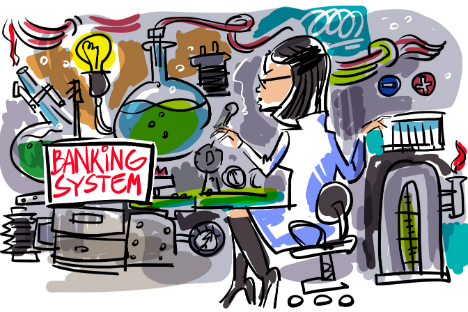
Drawing by Alexei Iorsh. Click to enlarge
Recently the entire world held its breath waiting for the Federal Reserve’s decision on whether or not to start increasing America’s key interest rate. When it received information about the rate remaining unchanged, the world exhaled, but more with disappointment than with relief. The problem of the ‘normalization’ of the monetary-credit policy has not been solved, but remains in limbo. Meanwhile, for the last year the Russian Central Bank has been trying to solve a major dilemma: how to reduce the key rate in order to stimulate the economy but at the same time prevent another wave of devaluation of the ruble. These efforts were appreciated by experts at Euromoney magazine, who named Elvira Nabiullina the best central banker of 2015. Nevertheless, Russian mass media is still highly critical of the Central Bank and its monetary-credit policy.
Yet the situation in the Russian economy today is highly complex. It seems
that in 2016 the Central Bank will not be able to enact an active credit
policy – that is to say, a quick growth of money volumes and a
reduction of the key rate.
However, the consequences of the “overproduction of credit” in developed
countries may become more painful for them than the issues that Russia is
overcoming today.
One of the number of problems to accumulate during the recent period of high oil prices has been the significant overvaluation of the ruble in real effective terms. It was generated both by the growth of export revenues and by the substantial inflows of capital, especially in the 2006-2008 period. The consequent decline of competitiveness and the growth of the private sector’s foreign debt provoked a deterioration of Russia’s balance of payments starting in 2011-2012. And the recent sanctions against Russia and the fall in oil prices made the preservation of the old currency and monetary model practically unviable.
In 2014 the Russian Central Bank made a painful decision to adopt a floating exchange rate and a policy of inflation targeting. It set the ambitious aim, especially in current conditions, of decreasing inflation in the next two-three years to 4 percent.
The policy that the Russian Central Bank is currently carrying out is very cautious: The key rate is kept at a safe-looking level, the growth rate of the capital offer is very moderate, and there are no interventions for increasing reserves or for annual refinancing in foreign currencies.
Such a policy can certainly be called severely anti-inflationary. Nevertheless,
inflation remains rather high: 12-14 percent. The problem is that the
Russian economy is open and the conditions of both the payment balance and the
budget are extremely dependent on oil prices and the ruble-dollar exchange
rate. This means that with a freely floating Russian
national currency, the ruble-dollar exchange rate must constantly adjust
to the changing expectations of oil prices.
As a result, the benefits
from devaluation are growing, and this then has an effect
on prices. In turn, this supports expectations of high inflation. And it is
very difficult to fight this for a policy that is based on the management of
the key rate. However, the Central Bank is still capable of maintaining this
elusive balance: It is reducing the key rate very cautiously in order to
restore credit for the economy and its growth.
Unfortunately, there are two problems that the Russian Central Bank may soon face.
First is the possible introduction of the quantitative easing policy in the United States to increase the key rate.
The second relates to Russia’s acceptance of the 2016 budget and the consequent establishment of an expected ruble price for oil in 2016. Each of these events may stop the process of further reducing the key rate or increase the risk of renewing the process of devaluation-inflation. The increase of world key rates, as is expected, may generate another wave of capital outflow from developing markets, including Russia. This may weaken the ruble and force the Central Bank to harden its policy in order to avoid further inflation.
The passing of the 2016 budget is creating heated
arguments inside the halls of power, making several things very clear: It
is impossible to guarantee an acceptable deficit, and preserving reserve
funds can only happen at the expense of reducing expenses or increasing the ruble
equivalent of export revenues. If expenses are not reduced and in 2016 oil
prices increase substantially, it is very likely that the ruble will weaken
even more. Not having the status of a reserve currency, the ruble is
deprived of the luxury that central banks from developed economies have: the
active “printing of money” to restore their economies’ growth.
Konstantin Korischenko is head of the
stock market and financial engineering department at the Finance and Banking
Faculty of the Russian Presidential Academy of National Economy and Public
Administration, and a former deputy chairman of the Russian Central Bank
All rights reserved by Rossiyskaya Gazeta.
Subscribe
to our newsletter!
Get the week's best stories straight to your inbox